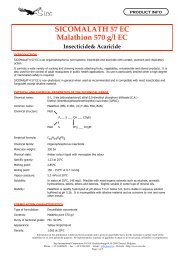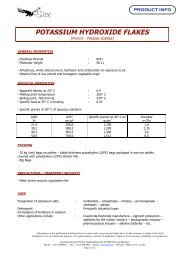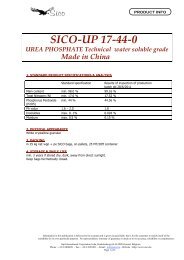SICOATE 40 EC - SAP International
SICOATE 40 EC - SAP International
SICOATE 40 EC - SAP International
You also want an ePaper? Increase the reach of your titles
YUMPU automatically turns print PDFs into web optimized ePapers that Google loves.
<strong>SICOATE</strong> <strong>40</strong> <strong>EC</strong><br />
DIMETHOATE <strong>40</strong>0 G/L <strong>EC</strong><br />
Insecticide (technical/formulations)<br />
PRODUCT INFO<br />
PHYSICAL AND CHEMICAL PROPERTIES<br />
Chemical name: 0,0-Dimethyl-S-methylcarbamoyl-methyl-phosphorodithioate (IUPAC)<br />
0,0-Dimethyl-S-(2(methylamino)-2-oxoethyl)-phosphorodithioate (CA)<br />
Common name: Dimethoate (BSI, E-ISO, ANSI, JMAF, ESA); fosmamid (URSS)<br />
Structural formula: MeO<br />
MeO S<br />
Empirical formula: C 5 H 12 NO 3 PS 2<br />
Moleculair weight: 229.28<br />
P – S – CH 2 – CO – NHMe<br />
Physical form: Colourless crystals (techn. 96%: white to greyish crystals)<br />
Specific gravity: 1.277 at 65°C<br />
Melting point: 51 - 52°C<br />
Boiling point: 117°C at 0.1 mm Hg<br />
Vapour pression: 1.1 mPa at 25°C<br />
Refractive index: ND65 1.5334<br />
Solubility: At 21°C, 25 g/l inwater. Readily soluble in most organic solvents (at 20°C):<br />
> 300 g/kg alcohols, benzene, chloroform, dichlormethane, ketones, toluene;<br />
> 50 g/kg carbon tetrachloride, saturated hydrocarbons, octan-1-oil.<br />
Stability: Relatively stable in aqueous media at pH 2 - 7. Hydrolyzed in alkaline solutions<br />
(50% hydrolysis occurs in 12 days at pH 9). Decomposes on heating.<br />
Corrosiveness: Slightly corrosive to iron.<br />
Compatibility: Compatible with most insecticides and fungicides, but incompatible with<br />
alkaline materials and with sulphur-based formulations.<br />
FORMULATION CHARACTERISTICS<br />
Formulation type: <strong>EC</strong> - Emulsifiable Concentrate<br />
Active ingredient content: Dimethoate (pure) <strong>40</strong>0 g/l<br />
Composition: Dimethoate (techn.) 416.7 g/l<br />
Solvents / emulsifiers/colouring matter (blue dye) 629.7 g/l<br />
Purity: Dimethoate technical min. 96.0%<br />
Appearance: Limpid blue liquid<br />
Density (at 20°C): 1.045 - 1.055<br />
Flash point (c.c.): Approx. + 31°C<br />
Emulsion characteristics: Initial emulsion stability and re-emulsification after 24 hrs: easy, complete<br />
(conform to CIPAC methods).<br />
Stability: No significant change in the physicochemical characteristics after accelerated<br />
aging test (14 days at 54°C +/- 1°C)<br />
Shelf life: Min. 2 years<br />
Information in this publication is believed to be accurate and is given in good faith, but is for the customer to satisfy itself of the<br />
suitability for its own particular purpose. No representation, warranty of guarantee is made as to its accuracy, reliability or completeness.<br />
Sap <strong>International</strong> Corporation NV/SA, Krekelenberg 69, B-2980 Zoersel, Belgium<br />
Phone : +32/3/3090651 – Fax : +32/3/3091931 – Email : info@sico.be - Website : Http://www.sico.be<br />
Page 1 of 4
BIOLOGICAL SP<strong>EC</strong>TRUM<br />
PRODUCT INFO<br />
This product is an emulsifiable concentrate insecticide containing <strong>40</strong>0 g/ltr. of Dimethoate, a wide range insecticide.<br />
Dimethoate is an organic phosphorus ester. It has an enduring systemic action in the control of plant sucking<br />
insects (e.g. aphid, sucking mites) miners and fruit borers. Additionally however, it is remarkably effective as a<br />
contact insecticide against a number of important chewing ectoparasites.<br />
Dimethoate is metabolised in the plant into non-toxic substances. About 3 weeks after treatment no appreciable<br />
residues will be left.<br />
METDHODS OF APPLICATION<br />
This product is to be mixed with water and may be applied with conventional dilute or concentrate ground sprayers.<br />
Add the required dose rate of the product to the half-filled tank and start agitation. Add the remaining water<br />
in the tank and spray the mixture immediately. The spray concentration depends on the type of spray equipment,<br />
the crop, the infestation pressure and the local experience.<br />
Chemical has quick knock-down effect and systemic activity lasts for up to 14 days. The product must be applied<br />
as soon as the first insects appear and repeat 2 - 3 weeks later or as necessary. Timing and number of sprays have<br />
to be decided in function of the level of infestation.<br />
Apply the low rates on small plants, small insects and light infestations of insects. Use intermediate rates on large<br />
insects and heavier infestations. Best results achieved when crop growing vigorously.<br />
Phytotoxicity: Do not use on Chrysanthemum and some other sensitive ornamentals. A preliminary phytotoxicity<br />
trial is recommended on a reduced scale before carrying out the actual treatment on citrus, olive, apricots and<br />
early peach varieties.<br />
Preharvest interval: In general approximately 2 weeks before cropping. Pertinent local statutory regulations<br />
must be complied with! Treated fodder crops must not be grazed or fed to live stock within 7 days after the last<br />
treatment.<br />
To avoid excessive residue at harvest do not exceed the maximum dosage per ha, or the time restriction between<br />
last application and harvest for each group listed in the table hereafter.<br />
IMPORTANT: The product is toxic to bees and should not be applied during the flowering period.<br />
RATES OF APPLICATION<br />
The rates of application varies according to pests, crops and local conditions.<br />
The following figures may serve as an indication.<br />
CROP PESTS RATE (ltr./ha)<br />
Cotton Thrips, aphids 0.30 - 1.20<br />
Mites, whitefly, jassids 0.50 - 1.20<br />
Lygus bugs, mealybug 0.60 - 1.25<br />
Tobacco Thrips, whitefly 0.60 - 1.10<br />
Aphids: seedbed 25 ml/10 ltr.<br />
field 0.60 - 1.00<br />
Sugar cane Aphids, hoppers, mealybugs 0.60 - 1.00<br />
Ground nuts Aphids, mites, leafhoppers, lygus bugs 0.50 - 1.10<br />
(leguminouses) whitefly, thrips<br />
Potato Mites, jassids, aphids 0.50 - 0.75<br />
Tomato, pepers, crucifers Mites, thirps, whitefly, fruitfly, leafminers, 0.60 - 1.10<br />
aphids, sawfly<br />
Vegetables Mites, lace bugs, aphids, leafminers, leafhoppers 0.<strong>40</strong> - 0.90<br />
mangold flies, etc.<br />
Cucurbits Mites, apids, leafhoppers, fruitfly, leafminers 0.<strong>40</strong> - 1.10<br />
Rice, sorghum Thrips, aphids, leafhoppers 0.<strong>40</strong> - 0.90<br />
Maize, wheat Rice stemborers, rice gall fly, rice leaf beetle 0.50 - 0.75<br />
Information in this publication is believed to be accurate and is given in good faith, but is for the customer to satisfy itself of the<br />
suitability for its own particular purpose. No representation, warranty of guarantee is made as to its accuracy, reliability or completeness.<br />
Sap <strong>International</strong> Corporation NV/SA, Krekelenberg 69, B-2980 Zoersel, Belgium<br />
Phone : +32/3/3090651 – Fax : +32/3/3091931 – Email : info@sico.be - Website : Http://www.sico.be<br />
Page 2 of 4
PRODUCT INFO<br />
CROP PESTS RATE (ml/100 ltr.)<br />
Forage crops, pastures Grasshoppers, lygus bugs, aphids, leafhoppers 0.50 - 1.25<br />
Stone and pome fruit Mites, aphids, fruitflies, mealybugs, psyllids, 50 - 125<br />
sawflies, may bug, codling moth, etc.<br />
Grape vines Mites, thrips, leafhopper, mealybug 50 - 100<br />
Berries Mites, aphids, raspberry beetle 50 - 100<br />
Citrus Mites, whitefly, leafminers, aphids 60 - 125<br />
Thrips, fruitflies 75 - 150<br />
Scales, mealybugs 100 - 200<br />
Mango Mites, leafhoppers, fruitfly, mealybugs 75 - 150<br />
Olive Thrips, olive moth 75 - 125<br />
Olive weevil, olive fly 100 - 150<br />
Banana Mites, aphids, mealybugs, fruitflies 60 - 100<br />
Coffee Mites, thrips, aphids, bugs 60 - 100<br />
Scales, mealybugs, leafminers 75 - 180<br />
Tea Aphids, mites, thrips, jassids, leafminer 75 - 110<br />
Seed-bug 150 - 200<br />
Cocoa Thrips, mealybugs 100 – 125<br />
TOXICOLOGY<br />
Active ingredient Dimethoate<br />
Acute oral - LD50 (rats) 310 mg/kg bw<br />
(mouse) 250 mg/kg bw<br />
(rabbit) <strong>40</strong>0 to 500 mg/kg bw<br />
Acute dermal - LD50 (rabbits) 800 mg/kg bw<br />
(rats) 600 to 1200 mg/kg bw<br />
Acute inhalation - LC50 (4h) (rats) 0.01 mg/l air<br />
Eye irritation (rabbits) Low-irritating<br />
Skin irritation (rabbits) Non-irritating<br />
Chronic toxicity NOEL 2-y feeding trials (rats) 0.2 mg/kg daily<br />
Acceptable daily intake for man 0.01 mg/kg bw<br />
Toxicity to fish Moderately toxic<br />
LC50 (96h) mosquito fish <strong>40</strong> - 60 mg/ltr.<br />
LC50 (96h) carp 278 mg/ltr.<br />
Toxicity to birds Moderately toxic<br />
LC50 oral mallard duck (female) <strong>40</strong> mg/ltr.<br />
LC50 oral pheasants (male) 15 mg/ltr.<br />
Toxicity to bees Toxic to bees<br />
Formulation<br />
Acute oral LD50 rat 560 mg/kg<br />
Acute dermal (calculated)LD50 rat > 2000 mg/kg<br />
Eye irritation (rabbits) Irritant<br />
Skin irritation (rabbits) Mild irritant<br />
Sensitisation (guinea-pig) Non sensitizer<br />
Toxicity to fish Harmful<br />
Toxicity to bees Toxic<br />
Information in this publication is believed to be accurate and is given in good faith, but is for the customer to satisfy itself of the<br />
suitability for its own particular purpose. No representation, warranty of guarantee is made as to its accuracy, reliability or completeness.<br />
Sap <strong>International</strong> Corporation NV/SA, Krekelenberg 69, B-2980 Zoersel, Belgium<br />
Phone : +32/3/3090651 – Fax : +32/3/3091931 – Email : info@sico.be - Website : Http://www.sico.be<br />
Page 3 of 4
SAFETY PR<strong>EC</strong>AUTIONS<br />
PRODUCT INFO<br />
The product is harmful by inhalation, if swallowed and in contact with skin. It is also irritating to skin.<br />
Observe also the general rules for handling the crop protection chemicals:<br />
* Keep out of reach of children, away from food, drink or feed.<br />
* Wear suitable protective clothing, rubber gauntlet gloves, goggles and respiratory mask.<br />
* When using, do not eat, drink or smoke.<br />
* Do not breathe spray mist.<br />
* Wash any contamination from skin or eyes immediately.<br />
* Wash hands and exposed skin before eating, drinking or smoking, before meals and after works.<br />
* This product contains an anticholinesterase compound. Do not use if under medical advice not to work with<br />
such compounds.<br />
* If you feel unwell, seek medical advice (show the label where possible).<br />
STORAGE AND DISPOSAL<br />
* Store in the original container, tightly closed, in a cool, well ventilated local, protected heat, away from other<br />
pesticides, fertilisers, food or feed.<br />
* Harmful to game, wild birds, livestock and poultry.<br />
* Harmful to fish: do not contaminate ponds, waterways or ditches with chemical or used container.<br />
* DO NOT RE-USE EMPTIED PRODUCT CONTAINERS. To prevent re-use, destroy rinsed non-combustible<br />
containers by puncturing and crushing. Dispose of containers preferably at a waste disposal site (landfill)<br />
approved for such use.<br />
EMERGENCY GUIDELINES<br />
Symptoms of poisoning<br />
Dimethoate is a cholinesterase inhibitor. Signs of overexposure develop after a latent period and may include:<br />
feeling of exhaustion, headache, blurred vision, weakness, confusion, vomiting, abdominal pain, excessive sweating,<br />
salivation, difficulty in breathing, arrhythmia and cardiac failure, unconsciousness and convulsions.<br />
First aid<br />
* I poisoned by skin absorption, remove all contaminated clothing and wash the patient thoroughly with plenty of<br />
water and soap; contaminated clothing should be laundered thoroughly before re-use.<br />
* In case of eye contact, flush eyes with copious amounts of water for at least 15 minutes.<br />
* If product has been swallowed, it should be noted that dimethoate is dissolved in solvents and that inducing<br />
vomiting then involves a risk of aspiration pneumotitis. Induce vomiting by thickling the back of the throat with<br />
a finger. Do not induce vomiting when the patient is unconscious.<br />
* Keep the patient at absolute rest.<br />
Note to physician<br />
If the product swallowed, perform rapid stomach lavage with 5% sodium bicarbonate, taking care to avoid aspiration<br />
into the lungs. Person with manifest peripheral symptoms, should be treated with 2 - 4 mg of atropine sulphate<br />
by intravenous injection. More atropine may be given as needed. In case of respiratory difficulties or convulsions,<br />
should be given atropine and a reactivator immediately. Allow no further exposure to any cholinesterase<br />
activity inhibitor until recovery is assured. Treat symptomatically. Put patient at complete rest in hospital<br />
for at least 72 hours.<br />
Contraindicated: morphine, barbiturates, phenothiazine, tranquillizers and central stimulants of all kinds.<br />
Every endeavour has been made to ensure that the information given herein is true and reliable but it is given only for the guidance of our customers.<br />
Sap <strong>International</strong> cannot accept any responsibility for loss or damage or infringement of patent rights, that may result from the use of<br />
information, due to the possibility of variations of processing or working conditions and of workmanship outside our control. Users are advised<br />
to confirm the suitability of the products with their own tests.<br />
Information in this publication is believed to be accurate and is given in good faith, but is for the customer to satisfy itself of the<br />
suitability for its own particular purpose. No representation, warranty of guarantee is made as to its accuracy, reliability or completeness.<br />
Sap <strong>International</strong> Corporation NV/SA, Krekelenberg 69, B-2980 Zoersel, Belgium<br />
Phone : +32/3/3090651 – Fax : +32/3/3091931 – Email : info@sico.be - Website : Http://www.sico.be<br />
Page 4 of 4

















